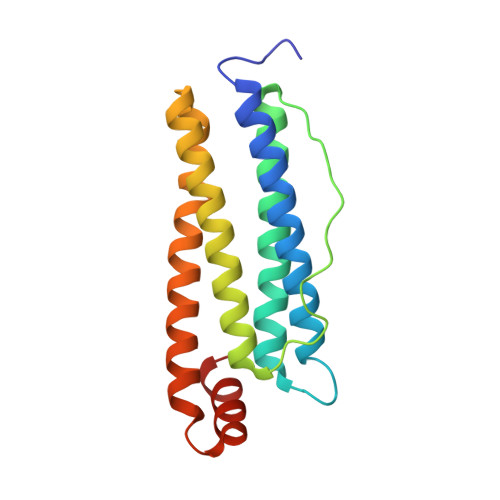Mechanism of Accumulation and Incorporation of Organometallic Pd Complexes into the Protein Nanocage of apo-Ferritin.
Abe, S., Hikage, T., Watanabe, Y., Kitagawa, S., Ueno, T.(2010) Inorg Chem 49: 6967-6973
- PubMed: 20586408
- DOI: https://doi.org/10.1021/ic1003758
- Primary Citation of Related Structures:
3AF7, 3AF8, 3AF9 - PubMed Abstract:
Hybridization of metal complexes and protein scaffolds is an important subject in bioinorganic chemistry and materials science. Efforts to provide non-natural functions to proteins will likely lead to advances in development of catalysts, sensors, and so on. Mechanistic investigations of the process of binding of metal complexes within protein scaffolds and characterization of the resulting coordination structures will help us to design and control coordination structures of metal complexes for construction of hybrid proteins containing metal complexes. In this work, the processes of accumulation and incorporation of organometallic palladium complexes within the cage of the iron storage protein apo-ferritin (apo-Fr) are elucidated by analysis of X-ray crystal structures of apo-Fr and selected mutants thereof, in the presence of the metal complexes. The crystal structure of apo-Fr containing Pd(allyl) (allyl = eta(3)-C(3)H(5)) complexes shows that thiolato-bridged dinuclear Pd(allyl) complexes are formed at two binding sites within the cage of apo-Fr. The crystal structures of apo-Fr and its Cys- and His-deletion mutants containing Pd(allyl) complexes indicate that Cys126 accelerates the incorporation of Pd(allyl) complexes into the cage. In addition, Cys48 and Cys126 are essential for accumulation of Pd(allyl) complexes and stabilizing the square planar coordination structure.
Organizational Affiliation:
Institute for Integrated Cell-Material Sciences (iCeMS), Funai Center, Kyoto University, Katsura, Nishikyo-ku, Kyoto 615-8510, Japan.



















